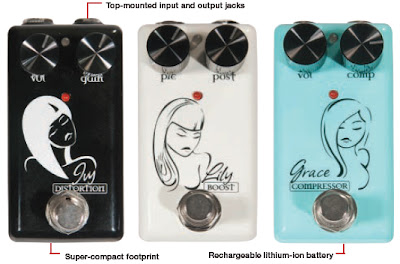Review:Red Witch Ivy Distortion,Lily Boost, andGrace Compressor
BY Matthew Holliman
We’re
used to guitar-gear inventors and engineers touting their wares and peppering
their pitch with words like revolutionary, innovative, and groundbreaking. Unfortunately
few of those promises lead to products that actually improve our experience as
players. Not all of these mad-scientists-withsoldering irons are hoax peddlers,however. With the introduction of the lithium-ion powered,
rechargeable Seven Sisters
line of effects, Ben Fulton of Red Witch Pedals may be able to count himself
among the tinkerers who have opened up new options for the gigging guitarist in
a real way. And given what these little pedals could mean for the player on the
go—or even players who rarely leave the house but have little dedicated space
for their gear—Red Witch may be on the brink of changing up the stompbox market
in a significant way. Here we check out the Ivy Distortion, Lily Boost, and
Grace Compressor.
More like the Seven
Dwarves
Red Witch is well known among pedal fiendsas a builder of
top-notch analog effects. But the Seven Sisters represents thinking beyondtried-and-true
templates for success. All of the Seven Sisters are housed in just about the tiniest
metal enclosures I’ve ever seen. We’re talking
miniscule here—a little bit bigger than a standard size matchbook and about an
inch tall. Small size doesn’t come at the expense of style, though. Each pedal
is painted with a high-gloss finish and adorned with a likeness of each pedal’s
namesake rendered in a minimalist, almost Japanese line-drawn style. In fact,
they wouldn’t look out of place as a high-fashion accessory. Each Sister has two knobs for adjusting
tone parameters as well as a sturdy
truebypass switch. To make their presence even less cumbersome the input and
output jacks are located at the top end of the box. If you were to purchase the
entire series and string them together, your pedalboard would be less than a foot
long. Sometimes smaller pedals can get a little squirrely underfoot. So
thoughtfully, Red Witch ships every Sister with textured rubber feet or a
pre-cut Velcro strip to affix to the bottom of the effect. Small size isn’t all
that makes the Seven Sisters special, of course. Red Witch claims to be the first company to put lithium-ion batteries inside an
effects pedal. What’s so cool about having a smart-phone battery in a guitar
effect? For starters, they’re rechargeable, which means freedom from unreliable
power sources, tangles of wire, and noise from shoddy club wiring. Just grab a
9V or 18V DC power supply and plug it into the lefthand power socket for 12
hours, and the pedal should provide one to two weeks worth of use before it
requires recharging. An LED mounted on the top of the box helps you monitor the
charge capacity. Red Witch dealers can replace these batteries, and the company
claims the cells should have a life of about two years.
Ivy Distortion
I tested Ivy, Lily, and
Grace with a Vox Pathfinder, a 10-watt CEC Toll-Free Express and a 50 watt ’68
Fender Bassman, both powering a 4x12 with V30 Celestions. Guitars of choice included
a Gibson Les Paul and a Fender Stratocaster. The
little black box of distortion named Ivy worked with the ’68 Bassman and the Les
Paul to bring on a monumental flex of power. With the volume knob at 12 o’clock
I got a level that was equal to the clean channel of the Bassman. And anything more
than made the Bassman sound like it was going to leap right through the
speakers to kill. As I found with most of the Sister series that have a hand in
overdriving your tone, rolling off guitar volume tames the tone for rhythmic
playing without sacrificing harmonic content. Ivy’s overall character is fairly
midcentric, and you’ll hear small cuts in both bass and treble when you engage
the effect. Dialing in the gain around 9 o’clock gave guitars a little more
treble bite and clarity that’s ideal for percussive rhythm styles. Pushing the
gain past 12 o’clock gets you a glassy lead tone that adds definition to your grungy
’90s skatepark jams—especially with an amp that’s already saturated and
breaking up like the lower-wattage CEC Express. With only two controls, Ivy
does suffer a little inflexibility in the tone department. Unlike some of the
other Sisters it does not have an internal trim pot for a third adjustment. This
certainly does not constitute a major setback though. Almost all of her configurations
are highly usable, and only those that need really piercing high-end lead or a
bloated rhythmic crunch will fail to find a useful distortion tone in the Ivy.
Lily Boost
Sometimes amps need a
little help. Those vintage million watt heads don’t always have a master
volume. And sometimes a distortion or fuzz pedal isn’t quite loud enough
 for a lead. Here’s where
the Lily boost comes into play. Lily has two variable controls the pre gain and
the post gain. The addition of a pre gain transforms this pedal into a pre-gain
stage in your effects loop. Post gain sets the overall output volume. What this
allows you to do is use Lily one of two ways: you can keep her pre low and post
high to give your signal an increase in volume, or you can push the pre
parameters into overdrive territory to give a natural break up feel. Using the
low gain channel on the 10-watt CEC Express, Lily kicked the little amp into a
sweet and robust overdrive zone with a cranked pre and post set around 1 o’clock.
Once the Express’s gain was set high enough, Lily’s juiced pre almost makes the
pedal work like a fuzz. Rolling down the pre and increasing the post will act
more like a volume boost for leads and color your tone less dramatically. The
extra headroom of the Bassman showcases this aspect of Lily’s performance
really well. And you’ll appreciate the work done on Red Witch’s part to retain
a guitar’s natural voice. It’s not stifled in the least and the Lily adds a
pleasant articulation to the notes.
for a lead. Here’s where
the Lily boost comes into play. Lily has two variable controls the pre gain and
the post gain. The addition of a pre gain transforms this pedal into a pre-gain
stage in your effects loop. Post gain sets the overall output volume. What this
allows you to do is use Lily one of two ways: you can keep her pre low and post
high to give your signal an increase in volume, or you can push the pre
parameters into overdrive territory to give a natural break up feel. Using the
low gain channel on the 10-watt CEC Express, Lily kicked the little amp into a
sweet and robust overdrive zone with a cranked pre and post set around 1 o’clock.
Once the Express’s gain was set high enough, Lily’s juiced pre almost makes the
pedal work like a fuzz. Rolling down the pre and increasing the post will act
more like a volume boost for leads and color your tone less dramatically. The
extra headroom of the Bassman showcases this aspect of Lily’s performance
really well. And you’ll appreciate the work done on Red Witch’s part to retain
a guitar’s natural voice. It’s not stifled in the least and the Lily adds a
pleasant articulation to the notes.
Grace Compressor
Grace, the aquamarine
compressor of the Seven Sisters can deliver a subtle squish to clean up a
wandering passage or carry a soaring lead. Much like Lily, Grace is more
versatile than she looks. Many players employ a compressor to equal out their clean
tone when switching from an overdrive or distortion. And with her volume control
set around 2 o’clock and comp at 1 o’clock, Grace gave my Stratocaster a
beautiful sustained and clean chiming quality that was a perfect match for the
Bassman. Increasing the volume past this setting makes Grace effectively act as
a boost. Infact, pushing this parameter into further extremes can works just as
well to overdrive an amp if you back off the comp setting. Grace’s compression
is brighter than say, an MXR DynaComp. At her most compressed Grace retains the
guitar’s subtle nuances while squeezing at a pronounced level, though it won’t
choke a signal quite as aggressively as a DynaComp—a limitation that probably
won’t estrange too many players. Grace worked especially well with single-coil
pickups and added body to other effects like the Eve Tremolo when placed first
in the effects chain.
The Verdict
The Seven Sisters pedals
are a pioneering innovation, and Fulton probably deserves a Boy Scout medal for
the work he’s done here. The Sisters’ small size means they’ll find homes on cluttered
boards, and they’re great for players who need an extra flavor without taking
up too much space. Any gear freak can always find another 1 1/2" spot to
jam in one of these gems, especially if they’ll last two weeks on the road
before a recharge. Getting these pedals through the airport for a fly-in gig
will be a breeze—no more bulky ATA flight cases for those one-off shows. And a
retail price of $129 per unit isn’t all
that bad for an analog effect with true-bypass and notably solid construction.
With normal upkeep and attention, it’s a fair bet these Sisters will age well and remain active onthe
pedalboards of gigging musicians for many years to come.
quoted from:




Comments
Post a Comment